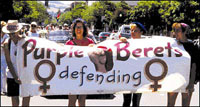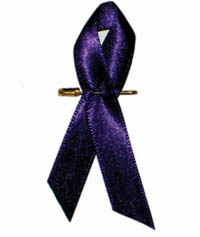The number of women murdered by their intimate partners in the United States in the last 11 years is equal to the number of U.S. soldiers killed in the Vietnam War.1 The United States expends much energy and resources for causes abroad, but there are still issues at home that need help. Just as war causes many deaths, so too does violence in the home. In addition to the sheer number of men and women involved in such abuse, domestic violence has a far-reaching impact on children, the future generation of society. Adolescents who have grown up in violent homes are at risk of perpetuating the abusive relationships of their parents/guardians. They are more likely to attempt suicide, abuse drugs and alcohol, run away from home, engage in teenage prostitution and other delinquent behavior, and commit sexual assault crimes.2 In fact, “a child’s exposure to the father abusing the mother is the strongest risk factor for transmitting violent behavior from one generation to the next.”3
Due to its private context, domestic violence runs the risk of being overlooked, especially amidst more outwardly demanding social and political issues such as war and terrorism. However, Gandhi’s concept of swadeshi teaches us to first work for change within ourselves, then extend our efforts outward to wider circles of influence. Swadeshi suggests that violence in the home must be addressed before a culture of nonviolence can be achieved.4 Two non-governmental organizations that propose divergent means through which to eliminate domestic violence are STAND! Against Domestic Violence and the Purple Berets. STAND! believes that we must change prevailing attitudes about violence through education, whereas the Purple Berets pursue policy change and retribution. While both education and legislation are important, STAND! embodies a more principled nonviolent approach.
Founded in 1977 by a group of concerned community members, STAND! was originally known as the Battered Women’s Alternative, “dedicated to serving battered women and their children through crisis counseling, support groups, and emergency shelter” in Contra Costa County.5 Since then BWA has changed its name and expanded its mission to reflect “the agency’s dual commitment to prevention and intervention strategies to bring an end to violence by challenging prevailing attitudes that tolerate relationship violence in homes and schools, between adults, among teens, and in the community at large.”6
STAND! views domestic violence as “learned and generational,” asserting that violence is a behavior that can be unlearned. In order to resolve the social problem of domestic violence as they see it, STAND! mobilizes community members in local schools. Volunteers run a program for seventh graders in the Mount Diablo school district. This four-day workshop, entitled “You Never Win With Violence,” promotes healthy, nonviolent relationships, and supplies information about campus and community resources. Through a role-play activity, the volunteers and staff seek to portray the realities of domestic violence, sometimes allowing seventh graders to become more aware of their own situation at home.
In addition to youth education, STAND! provides crisis and treatment services, which focus on “rebuilding lives.” After staying in emergency shelters, women who have been battered can live in “transitional housing,” a term that connotes a more constructive program than the idea of escape implied in the word “shelter.” Rather than protecting women in shelters, transitional housing provides a proactive means to achieve independence from an abusive household.
STAND! also promotes healing through support groups and counseling. The Domestic Violence Treatment Program for the people perpetrating abuse especially reflects this frame of restorative justice: “Reconciliation seeks to heal the wounds of violence and prevent further violence by promoting justice and diffusing hatred.”7 This method refuses to label the perpetrators as criminals, and instead works to rehabilitate them through counseling and healing.8 According to one volunteer whom I interviewed, the organization sees the act as an illness rather than a crime.9 By accepting the humanity of perpetrators, STAND! focuses not only on rebuilding the lives of victims, but also on rehabilitating the perpetrators.
In contrast, the Purple Berets focus primarily on criminal justice policy. Self-described as a “grassroots, in-your-face women’s rights group,” the Purple Berets seek legislative justice for female victims of sexual assault and domestic violence. They believe “the biggest problem of domestic violence is that it’s not treated as a crime.”10 The solutions they offer include direct advocacy to help ensure women’s cases move through the criminal justice system, along with political campaigning to change local policy and procedures.11 The group conveys an attitude of militancy through its name, Purple Berets, which alludes to the Green Berets special services unit during the Vietnam War.
The Purple Berets define domestic violence as a patriarchal power issue and a “hate crime.” The Purple Berets’ leader Tanya Brannan explains the organization’s view on the cause of domestic violence: “Men beat because they can get away with it. That’s where it all comes from.”12 Offenders perpetuate violence in the absence of stringent laws. While this may be true, the Purple Berets’ approach ignores the complexity behind violent impulses and behavior. The organization’s solution exemplifies a classic example of attacking the symptoms of a disease without understanding its root causes.
Unlike STAND!, the Purple Berets advocate retributive justice as both a deterrent and a way to rescue women who are “being beaten right now.”13 They view education as an insufficient means of combating domestic violence, and although Ms. Brannan admits that, “education is a piece of it,” she insists, “you can’t just teach little boys in school that domestic violence is wrong. If it was just an education problem, it would have been gone 30 years ago.” The Purple Berets disregard the shelter model and counseling services employed by organizations like STAND! and instead, solely advocate law enforcement: “In the real world, once the violence has reached a certain level, law enforcement is the only institution with the power to actually stop it […] So if, instead of women’s shelters, we put our time and resources into ensuring that domestic violence is prosecuted like any other violent crime, many of the problems victims face would disappear.”14
Despite a common goal to eliminate domestic violence, the Purple Berets and STAND! differ greatly in their treatment of the issue’s causes and solutions. Whereas the Purple Berets attribute domestic violence to a lack of criminal justice, STAND! addresses learned behavioral patterns. The Purple Berets’ approach of punishment contrasts with STAND!’s form of restorative justice: STAND! seeks to reconcile and rehabilitate the person, without dehumanizing him as a criminal.
I believe that the major strengths of STAND!’s approach arise from its foundation in principled nonviolence. The organization carries out peace education, reconciliation and healing, and a constructive program for the various parties affected by domestic violence. Through its ideas, publications, and programs, STAND! addresses domestic violence in a way that promotes nonviolence of thought, word, and deed, as taught by Martin Luther King Jr. and Gandhi. This consistency of thinking, speaking, and acting nonviolently supports a paradigm that requires more than the negative peace, or absence of violence, that the Purple Berets seem to stand for. Developing a culture of peace depends upon the presence of social justice, or positive peace, exemplified in STAND!’s “rebuilding of lives.”
1 United States Department of Justice. Violence by Intimates: Analysis of Data on Crimes by Current or Former Spouses, Boyfriends, and Girlfriends. March 1998.
2 STAND! http://www.standagainstdv.org
3 American Psychological Association. Report of the American Psychological Association Presidential Task Force on Violence and the Family. 1996.
4 Nagler, Michael. Is There No Other Way?: The Search for a Nonviolent Future. Berkeley Hills Books. 1st ed. 15 February 2001
5 STAND!
6 STAND!
7 Nagler, Michael, “The Steps of Nonviolence.” Fellowship of Reconciliation. 1999
8 STAND!
9 Duncan, Richard. Volunteer, STAND! Against Domestic Violence. Personal Interview. 11 November 2004.
10 Brannan, Tanya. Executive Director, Purple Berets. Personal Interview. 24 November 2004.
11 Purple Berets http://www.purpleberets.org
13 Purple Berets
14 Brannan


